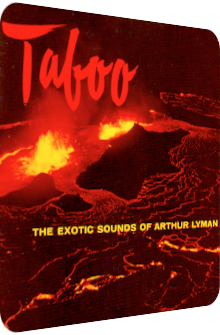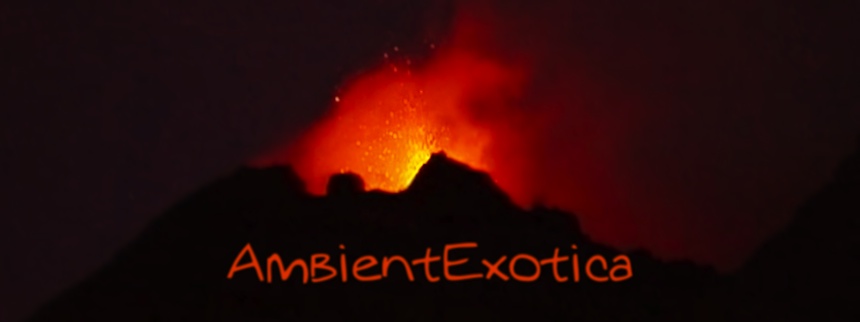
Arthur Lyman
Taboo
1958
Millions have been sold! The world changed completely! It's the real exotic debut of Arthur Lyman and his men that makes their first record Leis Of Jazz of 1957 look pale in comparison. It's Taboo, the enchanting pinnacle of Lyman's craftsmanship, and though I love all of his 58's and 59's albums, this particular work is a novelty that is rightfully mentioned next to Martin Denny's mono version of Exotica of 1957, on which Arthur Lyman played the vibraphone.
Having been inspired by the vivid bird calls of his then-bandmate Augie Colón, Taboo is the first album to contain Lyman's take on croaking, chirping and squawking. The band members remain the same as on his debut: John Kramer plays a variety of string and percussion instruments and supports Lyman with additional bird calls, Alan Soares is the pianist and second percussionist, with Harold Chang being the third percussion meister and xylophone player. Taboo features twelve renditions of well-known songs, with the occasional surprise and traditional song thrown in for good measure. A
rranged by Ethel Azama's then-current and soon-to-be pianist of the Gene Rains Group, Paul Conrad – who released his own debut Exotic Paradise later in the 60's –, Taboo is the hallmark of Arthur Lyman, with the first clear signs of dreamy landscapes, exotic rhythms and Far Eastern traits. Yes, it lacks a coherent focus and is often seen as an audacious copy of Martin Denny's style, but seriously, we're not talking about the East Coast vs. West Coast Hip Hop scheme here. I believe that fans of Exotica can and should have their respective favorites, as do I, but at the end of the day, I think that followers should love Denny and Lyman equally, if not for their personae, then for the fun activity of cherry picking and cream-skimming through their huge back catalog. With these rose-tinted thoughts in mind, let's get ready for Taboo.
Margarita Lecuona wrote the eponymous Latin piece in 1934 already, and it is one of the best known Jazz classics in general and most beloved Exotica songs in particular. In one sentence: Taboo is the opener. As I've written time and again, Les Baxter made this composition accessible to my ears on his pre-Exotica album Caribbean Moonlight of 1956, so all other versions are inferior to his Hollywood strings rendition in my book, even the hordes of latinized tries. But Arthur Lyman sure knows how a good retake of it should sound like. And thus he launches the album with Brazilian guiro shakers and piles of vivid bird calls. The piano melody is exchanged with nocturnally glinting vibraphones whose sustain is allowed to oscillate. The piano is still there, but it is Soares' task to accentuate the vibes with carefully dropped chords. Of particular success is the percussive vignette that is intersected in the middle of the track. I'm more than a bit sceptic about the incessant rhythm shifts in Lyman's debut Leis Of Jazz, but since the percussion consists of exotic bamboo rods and bongos, I am making a U-turn and praise the hell out of this short stop which is later accompanied by a purposefully cacophonous alto flute and majestic piano chords. In one last shift, the band revs up the tempo and presents a frantic bongo performance with allotted bird cries, making this an overall verbose, but delicately exotic piece.
Up next is a take on Ken Darby's Kalua, also known as Love Song Of Kalua. Lyman and his band surprise with a ukulele base frame, orchestra chimes and vibraphone goodness. The merging sustain of the vibes is delicious, the whole song is dreamy and is in fact the first of Lyman's dreamy renditions. It doesn't reach the hammock-compatible phantasmagoria of Martin Denny's take on Waipio, on which Lyman played the vibes as well, but is still a wonderfully clinging piece of ambience. As frantic as the opener Taboo is, the percussion is softly played and placed in the mix on Kalua. Most impressive.
Ringo Oiwake is next. This proper Japanese song by Masao Yoneyama and Fujio Ozawa is properly treated by Lyman. Every fissure of this track is filled with kitschy Japanese tone sequences and Far Eastern tonalities. A vibraphone-xylophone couple plays the cheeky main melody in staccato style while droning temple gongs, galloping bongos and awe-inspiring cascading sunset-fueled piano chords conflate mellifluously. They are a great counterpart to the occasionally tipsy and deliberately wonky five-note repetition of the mallet instruments. A great song for fans of Far Eastern song structures. The clichés actually work to the song's advantage!
Another stomper is approaching: Sea Breeze, written by Lou Busch, starts with a field recording of Hawaiian ocean waves, followed by delicately blurry vibraphone spirals that waft up and down, creating an utterly dreamy panorama that serves as a mystical background for Soares' piano droplets and the silky polyphony of the vibes. This song is, well, Ambient Exotica at its finest, almost on par with the aforementioned Waipio and clearly inspired by it. It is solemn pieces like this that make me forget Lyman's lackluster Jazz debut that preceded Taboo by one year. The mood is paradisiac, soothing and sumptuous, it is all about the sustain of the mallet instruments. My absolute favorite off Taboo, and my favorite of Lyman's many styles. A humble but gargantuan take.
While the Greek classic Misirlou is presented here in a double bass-fueled, bongo-driven and piano-focused manner that reciprocates between mystique and sunset-evoking majesty thanks to Soares' piano chords and the unexpected omission of any mallet instrument, China Clipper ends side A with a composition by arranger Paul Conrad himself, showing his love for the Eastern culture that he showcased later on his album Exotic Paradise. As one might expect, temple gongs, another infusion of galloping percussion and even slapped kotos or related zithers are all in here, providing another ambience intro before the song moves into jazzy territories with the Far Eastern eleven-note motif played on both the vibraphone and the piano. The cymbals, tambourins and triangles are used very carefully, as if not to boost the liveliness further. Side A is huge. Not one single dud, only winners, six in a row.
Side B is fired off with a rendition of Les Baxter's Sim Sim, and interestingly enough, it is also considered in the same year, 1958, by Martin Denny on his third exotic album Forbidden Island. In direct comparison, Lyman's version wins due to the vivid bird calls – which, on a side-note, are used in the very same running order on Vera Cruz off Lyman's 1958 album Bwana Ā – and the sunnier, mellower vibraphone melody in tandem with the high plasticity of the gentle percussion. The second phase sees this song transformed into a tribal thunderstorm of percussion goodness as it is already the case on Baxter's original. However, there's a little flaw worth mentioning that decreases the production value of this song, and it has to do with the aforementioned bird calls: not only are they re-used in Vera Cruz, but repeated three times on Sim Sim. Given the bird call talent of Lyman, this is a letdown, I have to admit. Nature is not that repetitive, and artificial bird calls shouldn't either.
Taboo is continued with a take on Franz Waxman's Katsumi Love Theme. What starts with the already known Far Eastern ingredients plus glittering wind chimes becomes an arrangement that shuttles incessantly between Japanese tone sequences and more Occidental piano notes. It's without a doubt the most jazzy rendition on the album, with no clear golden thread or distinct progression. It doesn't get any more convoluted on Taboo.
Up next is a wonderfully percussion-driven version of Duke Ellington's classic Caravan, and while its middle section resides in decidedly jazzy, double bass-backed territories and bathes in Honky Tonk piano accentuations, it's the percussion that rescues this otherwise uninspiring take. No shawm or sitar are featured, the used instruments sound all perfectly normal to Western ears. But the bongos make up for it. If they weren't used in this clear-cut fashion, Caravan could well have been included in Leis Of Jazz otherwise. Helen Parker's beautiful Akaka Falls is next, and Lyman exchanges the warped ukulele licks with balmy vibraphone notes that mimic the drugged sustain of the string instrument perfectly. John Kramer's ukulele is instead used as an accentuating device. Downspiraling vibraphone scintillae boost the paradisiac nature of the depicted diorama, the bird calls sound very life-like and are of the non-disturbing kind, as they never detract from the maintained reverie on the forefront. Additional piano chords round off this gorgeous ditty and bring side B back on the right track.
The traditional Dahil Sayo is another clear winner. Lyman's blurry vibraphones at the beginning seem to shimmer due to the evoked heat, but the biggest selling point is surely the greatly carved out main melody that is easily hummable. It's not as catchy as Misirlou, but pretty close. The second part gets even better, as the band goes Latin. Soares' jumpy piano chords and Chang's revved up percussion make this a superb rendition that captures my attention regularly. The final Hilo March is the mandatory quirky track that is found on most Exotica albums by Lyman or Denny. It is a vibraphone-laden military march full of whistles, a clear focus on the percussion and a jazzy intersection with quickly slapped double bass strings, and boldly audible bongos. It is surprisingly good thanks to the gentle piano chords, but definitely the weakest track off Taboo. It's no total letdown, just not exotic enough and thus a rather weak closer of a grandiloquent album.
Taboo is a strong second debut by Arthur Lyman. Leis Of Jazz was firmly rooted in jazzy realms despite its reference to the leis, but Taboo builds the base of the band's future success, although an overarching concept, harmony or coherence had yet to be established – think of the nocturnal latinization of Bahia or the magnanimous amount of thirteen (!) languorous ditties on Hawaiian Sunset, for instance. Side A off Taboo is almost too good to be true, with one magnificent track after the other. Not even Denny's Exotica delivers such a string of high-quality material right from the get-go, but that's up for debate and definitely not meant in a blasphemous way.
It's also worth noting that one of the main columns of the Exotica formula hasn't been established on this album yet: the use of overly exotic and alienating instruments. Temple gongs, bamboo rods and wind chimes are probably the best examples, but apart from the expected bongos and congas that fall into the same category, the colorful landscapes and destinations are all created with the vibraphone and the piano. The latter is especially present on every track and even beats the use of the vibraphone which is neglected on Misirlou. Make no mistake, Taboo is on par with Denny's Exotica, both of them deserved bestsellers and milestones of this humble genre. Bird calls, field recordings, lushness, dreaminess, jazzventures – it's all in here, and hence broadly available in all disc and file formats one might imagine. Taboo is, in my opinion at least, the real debut of Arthur Lyman's group as we know it. It's catchy, technicolored and even majestic in its depiction of calm and peacefulness. Hyper-recommended to every person that's even distantly interested in Exotica music.
Exotica Review 126: Arthur Lyman – Taboo (1958). Originally published on Sep. 29, 2012 at AmbientExotica.com.
